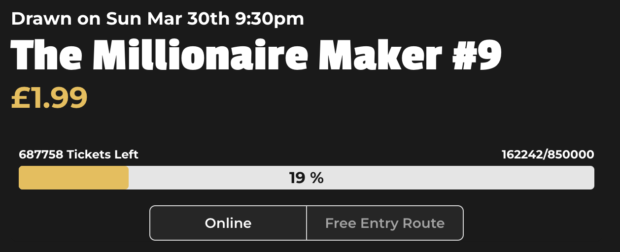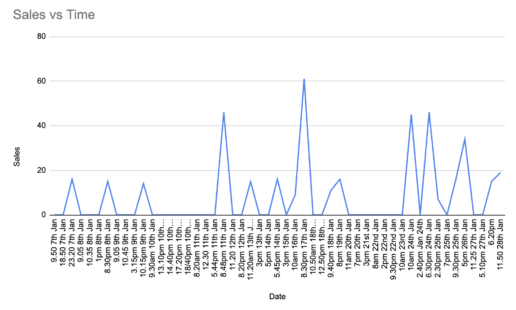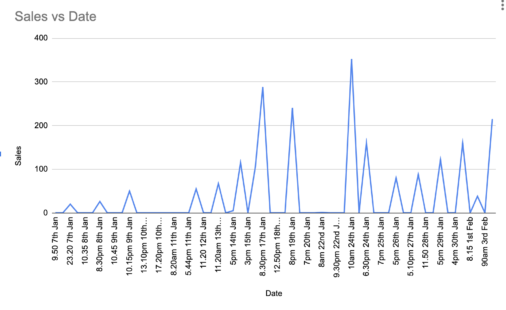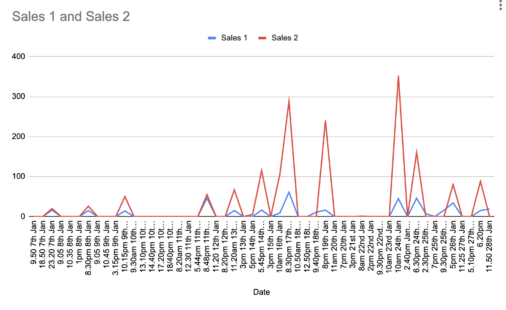You should upgrade or use an alternative browser.
Transparency Ideas For "Raffle" Competition Sites
- Start date
-
- Site or Brand Name Tag
- pay to enter sites win a house competitions

Pay to enter prize draw sites, sometimes referred to as raffle sites or simply competition sites, continue to grow. Despite what seems to be an ever increasing saturated market new sites appear all with the same vision of offering the lowest odds, biggest prizes and making a lot of money. As the sector matures we continue to read and hear stories of issues regarding dubious sites and underhand tactics. Add in issues that have appeared in the media about prizes not being paid out or competition sites being question by ASA and what you end up with is erosion of trust. This erosion initially starts with smaller brands but eventually will knock on to more established sites. One of our biggest concerns with respect to competition sites is ticket sale transparency. Over 12 months ago we published a blog asking "Can Pay To Enter Prize Draw Sites Be Fixed?" and then demonstrated how one site was obviously fudging their ticket sales numbers. Why? Well if a site is looking like it's successfully flogging tickets then genuine customers may be more inclined to pay and play - they don't know the numbers are fudged. The site takes in money and either carries on the con or eventually hits a point where they have enough customers to run fairly. In short fake it until you make it.
What Can You Do With Rogue Competition Sites?
Over the last 12 months we've had a few emails from players who have asked what they can do about competition sites they believe aren't playing fair. The problem is there's not a lot you can do. Advertising Standards is obviously one possible line of enquiry but whilst they can do things like rap a brand on the knuckles, it doesn't solve some issues. We thought Action Fraud would be a good option but they'll actually send you to Trading Standards. We've not tried Trading Standards but suspect that dealing with competition sites would be a new thing for them. However competition sites rely on a few things to exist. Sites need hosting, they need a platform and they need a payment gateway. In general other companies don't like be associated with folks scamming other folks out of cash. It's not good for business! Reporting potential dodgy sites to their hosting may help although in theory they could move to another host. A software platform - and we'll come to that below - may remove the site but then they could always pop up elsewhere. A payment gateway, they're the guys who process the debit cards etc, can remove their services making it impossible for the site to take money. No money = no site. And all this started to get us thinking.
The Lack Of Ticket Sales Transparency
Visit any competition site such as That Prize Guy, Rev Comps, Bounty Competitions, Elite Competitons, Bear Competitions etc and you'll see on pretty much every prize page an indication of how many tickets are available, how many tickets have been sold and how many are left.

If you visit that page at various times during the day then you'd expect to see the number of tickets sold increase and therefore the number of tickets left to buy decrease. This is actually your only indicator that sales are occurring. And just for brevity, in the time it's taken for us to upload the above image and write this paragraph sales have increased. This is what you'd expect on a successful and active site. The problem is that the majority of players don't have time - or even the inclination - to see how ticket sales perform. For larger established sites like those mentioned sales usually are incremental throughout the day, with possible peaks at busy marketing times and troughs during the night. But what about new sites or those that fly under the wing of the bigger guys?
Plotting Ticket Sales
During January we visited one competition site to see just how ticket sales changed during the day. Every time we visited we'd note down how many tickets were left to buy. What we found was long periods of 0 sales across all active prize draws and then sudden spikes. Interestingly the spikes tended to occur just once a day. In the graph below we're showing the change in sales between our visits running from 7th January until 28th January.

The above was for one competition, so what about another one that was running the same time? Again we see periods of zero sales and then sales occurring between visits. Now you could argue that sales may have dribbled out in the periods we didn't visit. They didn't! Numbers either tended to be static for long periods or jumped up.

But what happens if we overlay the two competitions? Now you hopefully see the point. In the times where 0 sales are being recorded both competitions had 0 sales. And that's the same for all the other promotions we monitored. In other words we believe that these numbers represent the site owner edging up the ticket sale ticker in order to make out to visitors that sales are going well.

The Plot Thickens
The above is for one site but another recently launched site also popped up on our radar. They launched with some nice holiday prizes and despite having little or no social following were selling tickets left, right and centre. So we checked in on them several times and again saw similar to the above. Long long periods of zero sales followed by jumps on all actives. Whilst it's not 100% proof of dubious activity it strongly suggests it. Sites with no visitors do not see sales like that! A third site, one we've only just been made aware of, currently has several prize draws with 0 sales but one with nearly 2000. For a site with 0 visitors and no social following that's highly questionable. We are keeping an eye on that one. But we need more evidence than just keeping an eye on sites every now and then and drawing graphs. Frustratingly, in order to prove the above conclusively (i.e. take out any reasonable doubt) we'd need to visit a site every minute of the day and plot that data. If a visitor was to see that, for example, a competition went for 23 hours and 59 minutes without a sale and then suddenly recorded 300 sales once during the day it might make them stop and think. Even more so when the same visual is seen for every prize draw that competition is running. Sadly we can't monitor 100s of sites every day in order to weed out the bad apples. It'd be lovely if we could. However there are possibilities and if implemented it could help bring much needed transparency to pay to enter competition sites.
Competition Site Platforms
A competition site platform is simply some software that's been created to help business owners run their site. Zap Competitions are one of the most well known but there's also Reffle and GFNI. In addition siteowners can create their own site using Wordpress and Woocommerce plugins. To confuse things some sites implement plugins that mean they're using Zap's set-up but not necessarily powered by them. Now we did contact Zap Competitions and ask whether they'd take action against site using their platform if that site was found to be acting inappropriately. They're "highly invested" in the industry and want it to be "transparent and reputable as possible". Reffle also got back us and would also cease to work with sites found to be acting underhand. Ideally we'd like to be 100% certain that no competition site owner can manipulate the number of sales in the back office. That'd be step one towards better transparency! Step two would be for Zap and co to instead of showing sales via a ticker, show sales via a graph. Players could instantly see how things are going, if there are strange troughs and more importantly strange peaks. In theory we'd expect sales to follow similar patterns across most competition sites. The data for this can easily be collected and produced on each prize draw page. However this still potentially allows a site owner to manipulate data if there's no restrictions - or if they know how to access databases. It's a start but it might not be sufficient.
The Payment Gateway Solution
A more robust approach would be if the sales graph data was provided by a third party. And - in theory - that could be done by the payment gateway. After all if a site is playing by the rules then the number of transactions going through the gateway should equate to the number of tickets sold. If a site is reporting 1000s of ticket sales but the gateway has only seen £1.50 then it's instantly evident that something is amiss. Now competition sites use a number of payment gateways. Square, NoChex and Cashflows are amongst the options that we've seen on UK competition sites. Cashflows actually positions itself as providing "payment services for the game of skill, competition and raffle sector". We have contacted them regarding two sites of concern but are yet to hear back from them. We'd love to know if they'd terminate partnerships if a site was found to be acting shady. As an aside we've also contacted Square about the site featured in the graphs and they are "investigating". Back to Cashflows, what if part of their package they provide third party confirmed sales to demonstrate that the site they're working with is 100% transparent. Players could see instantly if a site is selling tickets and avoid any that are either not working with Cashflows (or similar) or who aren't selling at all (and who perhaps previously were claiming 100s of visitors).
Will It Work? Can It Work?
How you take the steps to implement such an idea is up to the techie people but in terms of making the industry stronger it has some potential. We do think that platforms like Zap, GFNI and Reffle could implement sales graphs and also guarantees that ticket numbers can't be tampered with once a prize draw is live. Or perhaps add an indicator that "manual changes" have been made by the site owner at x times. That might make an owner stop and think before faking it until they make it. The payment gateway solution though feels more appropriate because it's a third party solution. It'd probably require API involvement and some techie things but it most certainly would act as a badge of transparency and offer confidence to the consumer. Competition sites that are passionate about the longevitiy of the sector would happily implement such changes. For the competition sector to get stronger it needs to weed out the bad apples before they turn everything rotten. Self-governing regulation is one possible, but if other stake holders in the sector step up with innovation - perhaps along the lines of the above - then that could be a massive help as well.
Transparency Ideas For "Raffle" Competition Sites Discussion
We're keen to hear your views on Transparency Ideas For "Raffle" Competition Sites. Join in the conversation below and share your experiences. You'll need to be registered with Loquax AND have made an initial hello post here to comment. Please note that comments may be moderated and may not always reflect the views of Loquax Ltd.
Related Articles
 The McVitie's 100K Birthday Giveaway
The McVitie's 100K Birthday Giveaway
 What Is The Elite Club At Elite Competitions?
What Is The Elite Club At Elite Competitions?
 What Is Happening With The Daily Magazine Comps?
What Is Happening With The Daily Magazine Comps?

